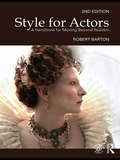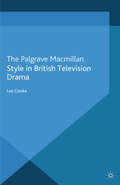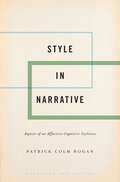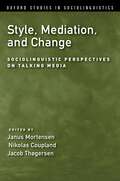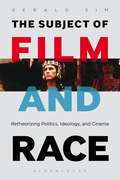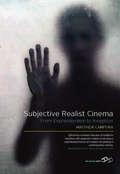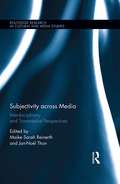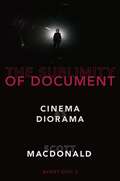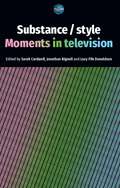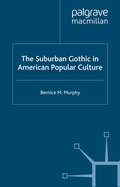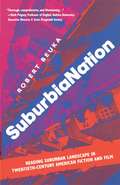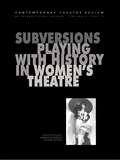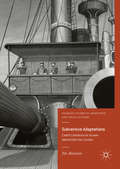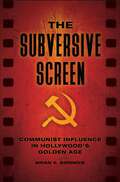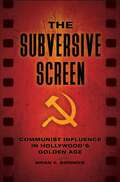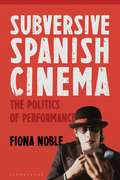- Table View
- List View
Style For Actors 2nd Edition: A Handbook for Moving Beyond Realism
by Robert Barton"Style is a journey from tourist to native. It is living in the world of the play, not just visiting it." - from Chapter One Anyone who has ever struggled with capes, fans, swords, doublets and crinolines should make Style for Actors 2nd Edition their constant companion. Robert Barton has completely updated his award winning handbook for the 21st century with contemporary references and up-to-date illustrations. This is the definitive guide to roles in historical drama. The past is a foreign country, and this outstanding book is concerned with exploring it from the actor’s point of view. Specific guides range from Greek, Elizabethan, Restoration and Georgian theatre to more contemporary stylings, including Futurism, Surrealism and Postmodernism. Barton takes great care to present the actor with the roles and genres that will most commonly confront them. His analysis moves from entire genres to specific scenes and characters. A huge resource of nearly 150 practical exercises helps a newfound understanding of style to make the leap from page to performance.
Style in British Television Drama (Palgrave Close Readings in Film and Television)
by L. CookeThis pioneering book provides detailed analysis of scenes from nine British television dramas produced between 1954 and 2001. Taking dinner table scenes as a recurring motif, the study analyses changes in televisual style with reference to production practices, technology, aesthetic preferences, and social and institutional change.
Style in Narrative: Aspects of an Affective-Cognitive Stylistics (Cognition and Poetics)
by Patrick Colm HoganLiterary style is something many people talk about, but few could define. Yet it is crucial for our response to narrative art. Style can facilitate or obscure the events of a story or the motivations of a character, enhance the aesthetic appeal of a narrative or complicate its emotional impact, and even inflect the political or ethical implications of a work. It is precisely this complex operation of style that Patrick Colm Hogan explains in Style in Narrative. Drawing on recent psychological research, this book proposes a new and clear definition of style and provides a systematic theoretical account of style in relation to cognitive and affective science. Hogan's definition stresses that style varies by both scope, or the range of text or texts that may share a style, and level, the components of an individual work that might involve a shared style. The book uses rich examples from literature, film, and graphic fiction, including analysis of Virginia Woolf's Mrs. Dalloway, Shakespeare's canon, William Faulkner's As I Lay Dying, and Art Spiegelman's Maus, as well as visual analysis of films by Robert Rodriguez, Deepa Mehta, Eric Rohmer, M.F.Husain, Yasujiro Ozu, and Chuan Lu. Through these studies Hogan identifies stylistic concerns common across mediums as well as the most consequential stylistic differences between them. Bringing together three often separated mediums within a coherent framework, Style in Narrative makes an important contribution to and necessary intervention in the field of stylistics.
Style in Narrative: Aspects of an Affective-Cognitive Stylistics (Cognition and Poetics)
by Patrick Colm HoganLiterary style is something many people talk about, but few could define. Yet it is crucial for our response to narrative art. Style can facilitate or obscure the events of a story or the motivations of a character, enhance the aesthetic appeal of a narrative or complicate its emotional impact, and even inflect the political or ethical implications of a work. It is precisely this complex operation of style that Patrick Colm Hogan explains in Style in Narrative. Drawing on recent psychological research, this book proposes a new and clear definition of style and provides a systematic theoretical account of style in relation to cognitive and affective science. Hogan's definition stresses that style varies by both scope, or the range of text or texts that may share a style, and level, the components of an individual work that might involve a shared style. The book uses rich examples from literature, film, and graphic fiction, including analysis of Virginia Woolf's Mrs. Dalloway, Shakespeare's canon, William Faulkner's As I Lay Dying, and Art Spiegelman's Maus, as well as visual analysis of films by Robert Rodriguez, Deepa Mehta, Eric Rohmer, M.F.Husain, Yasujiro Ozu, and Chuan Lu. Through these studies Hogan identifies stylistic concerns common across mediums as well as the most consequential stylistic differences between them. Bringing together three often separated mediums within a coherent framework, Style in Narrative makes an important contribution to and necessary intervention in the field of stylistics.
Style, Mediation, and Change: Sociolinguistic Perspectives on Talking Media (Oxford Studies in Sociolinguistics)
by Janus Mortensen Nikolas Coupland Jacob ThogersenTechnologically mediated talk is organized around familiar styles-styles of person, relationship and genre. But media also consistently remake and re-style these familiar patterns. This book brings together original research on media styling in different national contexts and languages, written by authors at the forefront of sociolinguistic research on mediated talk. It highlights and theorizes how creative acts of mediated styling can promote social and sociolinguistic change. The globalized world is already massively mediatized-what we know about language, people and society is necessarily shaped through our engagement with media. But talking media are caught up in wider currents of rapid change too. Creative innovations in media styling can heighten reflexive awareness, but they can also unsettle existing understandings of language-society relations. In reporting new investigations by expert researchers this book gives an original and timely account of how style, media and change need to be integrated further to advance the discipline of sociolinguistics.
STYLE, MEDIATION & CHANGE OSSL C: Sociolinguistic Perspectives on Talking Media (Oxford Studies in Sociolinguistics)
by Janus Mortensen, Nikolas Coupland and Jacob ThogersenTechnologically mediated talk is organized around familiar styles-styles of person, relationship and genre. But media also consistently remake and re-style these familiar patterns. This book brings together original research on media styling in different national contexts and languages, written by authors at the forefront of sociolinguistic research on mediated talk. It highlights and theorizes how creative acts of mediated styling can promote social and sociolinguistic change. The globalized world is already massively mediatized-what we know about language, people and society is necessarily shaped through our engagement with media. But talking media are caught up in wider currents of rapid change too. Creative innovations in media styling can heighten reflexive awareness, but they can also unsettle existing understandings of language-society relations. In reporting new investigations by expert researchers this book gives an original and timely account of how style, media and change need to be integrated further to advance the discipline of sociolinguistics.
The Subject of Film and Race: Retheorizing Politics, Ideology, and Cinema
by Gerald SimThe Subject of Film and Race is the first comprehensive intervention into how film critics and scholars have sought to understand cinema's relationship to racial ideology. In attempting to do more than merely identify harmful stereotypes, research on 'films and race' appropriates ideas from post-structuralist theory. But on those platforms, the field takes intellectual and political positions that place its anti-racist efforts at an impasse. While presenting theoretical ideas in an accessible way, Gerald Sim's historical materialist approach uniquely triangulates well-known work by Edward Said with the Neo-Marxian writing about film by Theodor Adorno and Fredric Jameson. The Subject of Film and Race takes on topics such as identity politics, multiculturalism, multiracial discourse, and cyborg theory, to force film and media studies into rethinking their approach, specifically towards humanism and critical subjectivity. The book illustrates theoretical discussions with a diverse set of familiar films by John Ford, Michael Mann, Todd Solondz, Quentin Tarantino, Keanu Reeves, and others, to show that we must always be aware of capitalist history when thinking about race, ethnicity, and films.
The Subject of Film and Race: Retheorizing Politics, Ideology, and Cinema
by Gerald SimThe Subject of Film and Race is the first comprehensive intervention into how film critics and scholars have sought to understand cinema's relationship to racial ideology. In attempting to do more than merely identify harmful stereotypes, research on 'films and race' appropriates ideas from post-structuralist theory. But on those platforms, the field takes intellectual and political positions that place its anti-racist efforts at an impasse. While presenting theoretical ideas in an accessible way, Gerald Sim's historical materialist approach uniquely triangulates well-known work by Edward Said with the Neo-Marxian writing about film by Theodor Adorno and Fredric Jameson. The Subject of Film and Race takes on topics such as identity politics, multiculturalism, multiracial discourse, and cyborg theory, to force film and media studies into rethinking their approach, specifically towards humanism and critical subjectivity. The book illustrates theoretical discussions with a diverse set of familiar films by John Ford, Michael Mann, Todd Solondz, Quentin Tarantino, Keanu Reeves, and others, to show that we must always be aware of capitalist history when thinking about race, ethnicity, and films.
Subjective Realist Cinema: From Expressionism to <i>Inception</i>
by Matthew CamporaSubjective Realist Cinema looks at the fragmented narratives and multiple realities of a wide range of films that depict subjective experience and employ “subjective realist” narration, including recent examples such as Mulholland Drive, Memento, and Eternal Sunshine of the Spotless Mind. The author proposes that an understanding of the narrative structures of these films, particularly their use of mixed and multiple realities, enhances viewers’ enjoyment and comprehension of such films, and that such comprehension offers a key to understanding contemporary filmmaking.
Subjectivity across Media: Interdisciplinary and Transmedial Perspectives (Routledge Research in Cultural and Media Studies)
by Jan-Noël Thon Maike Sarah ReinerthMedia in general and narrative media in particular have the potential to represent not only a variety of both possible and actual worlds but also the perception and consciousness of characters in these worlds. Hence, media can be understood as "qualia machines," as technologies that allow for the production of subjective experiences within the affordances and limitations posed by the conventions of their specific mediality. This edited collection examines the transmedial as well as the medium-specific strategies employed by the verbal representations characteristic for literary texts, the verbal-pictorial representations characteristic for comics, the audiovisual representations characteristic for films, and the interactive representations characteristic for video games. Combining theoretical perspectives from analytic philosophy, cognitive theory, and narratology with approaches from phenomenology, psychosemiotics, and social semiotics, the contributions collected in this volume provide a state-of-the-art map of current research on a wide variety of ways in which subjectivity can be represented across conventionally distinct media.
Subjectivity across Media: Interdisciplinary and Transmedial Perspectives (Routledge Research in Cultural and Media Studies)
by Jan-Noël Thon Maike Sarah ReinerthMedia in general and narrative media in particular have the potential to represent not only a variety of both possible and actual worlds but also the perception and consciousness of characters in these worlds. Hence, media can be understood as "qualia machines," as technologies that allow for the production of subjective experiences within the affordances and limitations posed by the conventions of their specific mediality. This edited collection examines the transmedial as well as the medium-specific strategies employed by the verbal representations characteristic for literary texts, the verbal-pictorial representations characteristic for comics, the audiovisual representations characteristic for films, and the interactive representations characteristic for video games. Combining theoretical perspectives from analytic philosophy, cognitive theory, and narratology with approaches from phenomenology, psychosemiotics, and social semiotics, the contributions collected in this volume provide a state-of-the-art map of current research on a wide variety of ways in which subjectivity can be represented across conventionally distinct media.
The Sublimity of Document: Cinema as Diorama
by Scott MacDonaldThe Sublimity of Document: Cinema as Diorama is a collection of in-depth, substantive interviews with moving-image artists working "avant-doc, that is, making films that explore the territory between documentary and experimental cinema. The book uses the early history of the museum habitat diorama of animal life, specifically the Hall of African Mammals at the American Museum of Natural History, as a way of rethinking both early and modern cinema document--and especially those recent filmmakers and films that are devoted to providing viewers with panoramic documentations of places and events that otherwise they might never have opportunities to experience in person. This international collection of 27 interviews follows on MacDonald's earlier Avant-Doc: Intersections of Documentary and Avant-Garde Cinema (Oxford, 2015). The interviews, organized panoramically within the collection, are dense with information and insight, and readable by specialists and non-specialists alike. In most instances, these are the most in-depth and expansive-sometimes the first-interviews with these filmmakers. Together, these interviews offer an engaging panorama of the recent history and geography of cinema devoted to documenting the world around us, as well as an in-depth look at the challenges and accomplishments of filmmakers willing to go anywhere on the planet (or on the internet!) to document what they believe we need to see. MacDonald's general introduction provides an overall context for the collection, which includes interviews with Ron Fricke, Gustav Deutsch, Laura Poitras, Fred Wiseman, Nikolaus Geyrhalter, Bill Morrison, Brett Story, Abbas Kiarostami, Lois Patiño, Dominic Gagnon, Erin Espelie, Yance Ford, Janet Biggs, Carlos Adriano, Craig Johnson, Ben Russell, Betzy Bromberg, James Benning, Maxim Pozdorovkin, along with several veterans of Harvard's Sensory Ethnography Lab (and with the executive directors of the distributor, Documentary Educational Resources, which has served the field of independent documentary for nearly fifty years)--each interview is introduced with MacDonald's overview of the interviewee's life and work. The book includes filmographies and selected bibliographies for all the filmmakers.
The Sublimity of Document: Cinema as Diorama
by Scott MacDonaldThe Sublimity of Document: Cinema as Diorama is a collection of in-depth, substantive interviews with moving-image artists working "avant-doc, that is, making films that explore the territory between documentary and experimental cinema. The book uses the early history of the museum habitat diorama of animal life, specifically the Hall of African Mammals at the American Museum of Natural History, as a way of rethinking both early and modern cinema document--and especially those recent filmmakers and films that are devoted to providing viewers with panoramic documentations of places and events that otherwise they might never have opportunities to experience in person. This international collection of 27 interviews follows on MacDonald's earlier Avant-Doc: Intersections of Documentary and Avant-Garde Cinema (Oxford, 2015). The interviews, organized panoramically within the collection, are dense with information and insight, and readable by specialists and non-specialists alike. In most instances, these are the most in-depth and expansive-sometimes the first-interviews with these filmmakers. Together, these interviews offer an engaging panorama of the recent history and geography of cinema devoted to documenting the world around us, as well as an in-depth look at the challenges and accomplishments of filmmakers willing to go anywhere on the planet (or on the internet!) to document what they believe we need to see. MacDonald's general introduction provides an overall context for the collection, which includes interviews with Ron Fricke, Gustav Deutsch, Laura Poitras, Fred Wiseman, Nikolaus Geyrhalter, Bill Morrison, Brett Story, Abbas Kiarostami, Lois Patiño, Dominic Gagnon, Erin Espelie, Yance Ford, Janet Biggs, Carlos Adriano, Craig Johnson, Ben Russell, Betzy Bromberg, James Benning, Maxim Pozdorovkin, along with several veterans of Harvard's Sensory Ethnography Lab (and with the executive directors of the distributor, Documentary Educational Resources, which has served the field of independent documentary for nearly fifty years)--each interview is introduced with MacDonald's overview of the interviewee's life and work. The book includes filmographies and selected bibliographies for all the filmmakers.
Substance / style: Moments in television (The Television Series)
by Jonathan Bignell Lucy Fife Donaldson Sarah CardwellAn exciting new strand in The Television Series, the ‘Moments in Television’ collections celebrate the power and artistry of television, whilst interrogating key critical concepts in television scholarship.Each ‘Moments’ book is organised around a provocative binary theme. Substance / styleoffers fresh perspectives on television’s essential qualities and aesthetic significance. It reassesses the synergy between substance and style, highlighting the potential for meaning to arise through their integration. The book’s chosen programmes are persuasively illuminated in new ways.The book explores an eclectic range of TV fictions, dramatic and comedic. Contributors from diverse perspectives come together to expand and enrich the kind of close analysis most commonly found in television aesthetics. Sustained, detailed programme analyses are sensitively framed within historical, technological, institutional, cultural, creative and art-historical contexts.
Substance / style: Moments in television (The Television Series)
by Jonathan Bignell Steven Peacock Lucy Fife Donaldson Sarah CardwellAn exciting new strand in The Television Series, the ‘Moments in Television’ collections celebrate the power and artistry of television, whilst interrogating key critical concepts in television scholarship.Each ‘Moments’ book is organised around a provocative binary theme. Substance / styleoffers fresh perspectives on television’s essential qualities and aesthetic significance. It reassesses the synergy between substance and style, highlighting the potential for meaning to arise through their integration. The book’s chosen programmes are persuasively illuminated in new ways.The book explores an eclectic range of TV fictions, dramatic and comedic. Contributors from diverse perspectives come together to expand and enrich the kind of close analysis most commonly found in television aesthetics. Sustained, detailed programme analyses are sensitively framed within historical, technological, institutional, cultural, creative and art-historical contexts.
The Suburban Gothic in American Popular Culture
by B. MurphyThe first sustained examination of the depiction of American suburbia in gothic and horror films, television and literature from 1948 to the present day. Beginning with Shirley Jackson's The Road Through the Wall , Murphy discusses representative texts from each decade, including I Am Legend , Bewitched , Halloween and Desperate Housewives .
SuburbiaNation: Reading Suburban Landscape in Twentieth Century American Film and Fiction
by R. BeukaThe expansion of the suburban environment is a fascinating cultural development. In fact, the United States is primarily a suburban nation, with far more Americans living in the suburbs that in either urban or rural areas. Why were suburbs created to begin with? How do we define them? Are they really the promised land of the American middle class? The concept of space and how we create it is a concept that is receiving a great deal of academic attention, but no one has looked carefully at the suburban landscape through the lens of fiction and of film.
Subversions
by Erika Block Gabriele Griffin Julie WilkinsonFirst Published in 1998. Routledge is an imprint of Taylor & Francis, an informa company.
Subversions
by Erika Block Gabriele Griffin Julie WilkinsonFirst Published in 1998. Routledge is an imprint of Taylor & Francis, an informa company.
Subversive Adaptations: Czech Literature on Screen behind the Iron Curtain
by Petr BubeníčekThis book deals with film adaptations of literary works created in Communist Czechoslovakia between 1954 and 1969, such as The Fabulous World of Jules Verne (Zeman 1958), Marketa Lazarová (Vláčil 1967), and The Joke (Jireš 1969). Bubeníček treats a historically significant period around which myths and misinformation have arisen. The book is broad in scope and examines aesthetic, political, social, and cultural issues. It sets out to disprove the notion that the state-controlled film industry behind the Iron Curtain produced only aesthetically uniform works pandering to official ideology. Bubeníček’s main aim is to show how the political situation of Communist Czechoslovakia moulded the film adaptations created there, but also how these same works, in turn, shaped the sociocultural conditions of the 1950s and the 1960s.
Subversive Adaptations: Czech Literature on Screen behind the Iron Curtain
by Petr BubeníčekThis book deals with film adaptations of literary works created in Communist Czechoslovakia between 1954 and 1969, such as The Fabulous World of Jules Verne (Zeman 1958), Marketa Lazarová (Vláčil 1967), and The Joke (Jireš 1969). Bubeníček treats a historically significant period around which myths and misinformation have arisen. The book is broad in scope and examines aesthetic, political, social, and cultural issues. It sets out to disprove the notion that the state-controlled film industry behind the Iron Curtain produced only aesthetically uniform works pandering to official ideology. Bubeníček’s main aim is to show how the political situation of Communist Czechoslovakia moulded the film adaptations created there, but also how these same works, in turn, shaped the sociocultural conditions of the 1950s and the 1960s.
The Subversive Screen: Communist Influence in Hollywood's Golden Age
by Brian E. BirdnowA riveting chronicle of Communist Party efforts to propagate Communism in the United States, concurrent with Hollywood's "Golden Age" of creativity that came to define classical Hollywood cinema.From the Great Depression through World War II, the American Communist Party tried to take control of the motion picture industry. This comprehensive and chronological account of Communist influence in Hollywood surveys the topic from the Popular Front's fight against Fascism during the 1930s to the height of the House Un-American Activities Committee hearings in the late 1940s.Birdnow, an established historian and chronicler of domestic Communism, outlines Communist International's organizational efforts promoting international communism, focusing on the work of Communist political activists such as Willi Münzenberg, a media mogul with an international network; Gerhart Eisler, patron of a Hollywood composer; and Otto Katz, a high-profile publicist of the party line involved in movies in the 1930s and 1940s. The book explores the covert ways in which Hollywood Communists and Soviet sympathizers attempted to tailor movie scripts to suit the Soviet agenda and discusses Communist front groups such as the Hollywood Anti-Nazi League in great detail. Final chapters offer convincing proof that the directors, producers, and screenwriters blacklisted by studios for their possible Communist affiliations, known as the Hollywood Ten, were members of the Communist Party.
The Subversive Screen: Communist Influence in Hollywood's Golden Age
by Brian E. BirdnowA riveting chronicle of Communist Party efforts to propagate Communism in the United States, concurrent with Hollywood's "Golden Age" of creativity that came to define classical Hollywood cinema.From the Great Depression through World War II, the American Communist Party tried to take control of the motion picture industry. This comprehensive and chronological account of Communist influence in Hollywood surveys the topic from the Popular Front's fight against Fascism during the 1930s to the height of the House Un-American Activities Committee hearings in the late 1940s.Birdnow, an established historian and chronicler of domestic Communism, outlines Communist International's organizational efforts promoting international communism, focusing on the work of Communist political activists such as Willi Münzenberg, a media mogul with an international network; Gerhart Eisler, patron of a Hollywood composer; and Otto Katz, a high-profile publicist of the party line involved in movies in the 1930s and 1940s. The book explores the covert ways in which Hollywood Communists and Soviet sympathizers attempted to tailor movie scripts to suit the Soviet agenda and discusses Communist front groups such as the Hollywood Anti-Nazi League in great detail. Final chapters offer convincing proof that the directors, producers, and screenwriters blacklisted by studios for their possible Communist affiliations, known as the Hollywood Ten, were members of the Communist Party.
Subversive Spanish Cinema: The Politics of Performance
by Fiona NobleA camp lipsynched routine by three air stewards distracts unsuspecting passengers from the fact that their plane is to make a crash landing. Performance functions as a diversion from unsavoury realities. In this way, Pedro Almodóvar's 2013 film I'm So Excited adopts a strategy of subversive anti-establishment censor-evading filmmaking practices under Franco. Contemporary cinematic performance in Spain intersects with politics to provide a platform for views and voices that do not conform to the dominant political narrative. An essential text for scholars, students and aficionados of Spanish cinema, Subversive Spanish Cinema: The Politics of Performance is the first single-authored monograph to focus on performance in this context. The book analyses interactions between performance and politics in technical and conceptual terms considering, for example, performance styles, the narrative role of performance and political interventions by actors such as Javier Bardem and Juan Diego Botto. Ultimately, Subversive Spanish Cinema: The Politics of Performance posits performance, within the specific context of contemporary Spanish cinema, as a politically-potent device and proposes that it is precisely for this reason that the arts have borne the brunt of aggressive austerity measures enforced by Spain's conservative government in recent years.
Subversive Spanish Cinema: The Politics of Performance
by Fiona NobleA camp lipsynched routine by three air stewards distracts unsuspecting passengers from the fact that their plane is to make a crash landing. Performance functions as a diversion from unsavoury realities. In this way, Pedro Almodóvar's 2013 film I'm So Excited adopts a strategy of subversive anti-establishment censor-evading filmmaking practices under Franco. Contemporary cinematic performance in Spain intersects with politics to provide a platform for views and voices that do not conform to the dominant political narrative. An essential text for scholars, students and aficionados of Spanish cinema, Subversive Spanish Cinema: The Politics of Performance is the first single-authored monograph to focus on performance in this context. The book analyses interactions between performance and politics in technical and conceptual terms considering, for example, performance styles, the narrative role of performance and political interventions by actors such as Javier Bardem and Juan Diego Botto. Ultimately, Subversive Spanish Cinema: The Politics of Performance posits performance, within the specific context of contemporary Spanish cinema, as a politically-potent device and proposes that it is precisely for this reason that the arts have borne the brunt of aggressive austerity measures enforced by Spain's conservative government in recent years.
